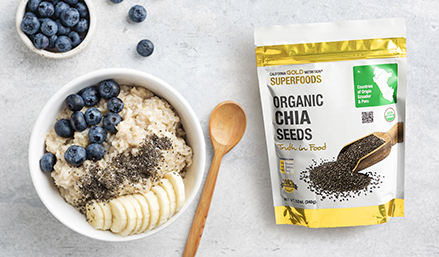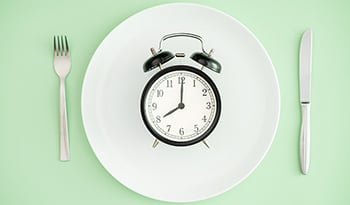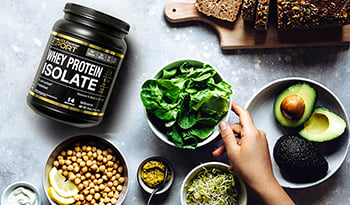4 Replenishing Recipes to Break Your Fast With
DISCLAIMER:This blog does not intend to provide diagnosis...
- In this article:
- 4 Popular Ways To Do Intermittent Fasting
- Health Benefits of Fasting
- Fasting Tips
- What to Eat to Break Your Fast
- 1. Collagen Berry Banana Smoothie Recipe
- 2. Quinoa, Chickpea, and Salmon Salad Recipe
- 3. Easy Overnight Oatmeal Recipe
- 4. Red Lentil Vegetable Soup Recipe

“Fasting is the single greatest natural healing therapy. It is nature’s ancient, universal ‘remedy’ for many problems.”—Elson M. Haas, M.D.
Intermittent fasting is one of the hottest diet trends. Google it and you’ll get over 77 million hits! As trendy as it may appear, though, fasting itself is an ancient practice that has been utilized for spiritual and physical health for thousands of years.
Numerous religions and spiritual disciplines, like yoga, incorporate short-term (lasting for a few hours) or long-term fasts (lasting for weeks, usually with people dining at night) into their practices. The spiritual benefits may include increased clarity, recharging your divine batteries, and increasing compassion for people in need.
4 Popular Ways To Do Intermittent Fasting
Fasting entails voluntarily abstaining from food or drink (or both). Done for a specific period of time, fasting can be conducted completely or partially (for example, just consuming juices) and for long or short periods.
Intermittent fasting refers to a variety of different meal timing schedules where you cycle between voluntary fasting and eating over a specific time period. The main difference between intermittent fasting and other dietary approaches, like calorie counting or keto, is that you focus on when you eat rather than what you eat.
There are a variety of intermittent fasting regimes. Four of the most popular are:
- Overnight Fast: The easiest approach; you have a 12-hour window to eat and a 12-hour window to fast
- 5:2 or 6:1 Fast: You eat regularly 5 or 6 days per week and lightly (500-600 calories a day) 1-2 days per week
- The 16/8 method: You fast for 14-16 hours, and eat during an 8-10 hour window. The easiest way to do it is to skip breakfast and stop eating after 8 p.m.
- Whole Day Fast: You eat one meal a day 1-2 times per week and regularly 5-6 days.
Health Benefits of Fasting
According to Dr. Elson Haas, one of the leading practitioners of integrative medicine, the benefits of fasting include increased energy, clearer skin, weight loss, rejuvenation, a stronger immune system, and better sleep. When you fast, you rest your digestive system and free energy that can be directed towards eliminating toxins from the colon, kidneys, bladder, lungs, and skin. Fasting also promotes autophagy, a process where unnecessary or damaged cells are removed.
While more research is needed, studies have found that intermittent fasting can have numerous metabolic benefits. These include a reduction in body weight and body fat, improved blood lipids, decreased blood pressure, and better regulation of blood sugar.
Research has also found that fasting can reduce inflammation, which is a normal immune process that can have a negative impact on your health, increasing the risk of cancer, heart disease, and rheumatoid arthritis. Animal studies have found that fasting may enhance brain health and increase longevity
Fasting Tips
If you are new to fasting, rather than going a full day without eating, start small by fasting for a short period such as 12 hours. This can help you avoid common adverse effects such as feeling tired, hungry, or moody.
Make sure to stay hydrated by drinking plenty of water. This is particularly important because it can be easy to mistake thirst for hunger. During fast periods you can freely consume calorie-free beverages such as black coffee or tea. A little caffeine can help you stay focused and energized during fast periods.
Since you are eating less, it’s important to consume high-quality foods when you do eat rather than empty calories. This means eating plenty of plant-based whole foods including fruits, vegetables, beans, nuts and seeds, and whole grains. Not only are these foods packed with nutrients, but they also contain fiber, which will help you stay full longer.
To minimize muscle loss and maximize satiety make sure to eat adequate protein. You may also want to take a multivitamin and mineral supplement with meals that contain the recommended RDA for your age and gender to make sure you are meeting your nutritional requirements.
It’s a good idea to discuss fasting with your physician, particularly if you are contemplating a longer fast. Women who are pregnant or breastfeeding, people with diabetes, or individuals with a history of eating disorders should probably not attempt fasting.
What to Eat to Break Your Fast
To keep your gut happy, minimize blood sugar spikes, and move into the fed state after a fast, eat small portions of easy-to-digest foods. While hunger may make it tempting to grab foods high in fat, refined carbs, and sugar — like pizza, cookies, or macaroni and cheese — doing so can result in tummy distress and bloating. If you reach for high-calorie junk food during eating windows you also won’t be as likely to lose weight.
Great choices for breaking the fast include nutrient-rich, easily digestible fruits (dates are a favorite food for this in the Middle East), fermented foods like unsweetened yogurt or sauerkraut, healthy fats like avocado, and easy to digest proteins like bone broth, eggs, and canned fish packed in water such as light tuna or Alaskan salmon. Kitchari, an Ayurvedic porridge made from mung beans, rice, and blood sugar balancing spices like ginger is also a nice break your fast option.
Here are four of my favorite replenishing recipes to break your fast with.
1. Collagen Berry Banana Smoothie Recipe
Serves 1
Smoothies are a great way to refuel after a fast because they are nutritious, filling, easy to digest, and simple to make. This one is rich in superfoods like chia seeds, flaxseeds, cocoa nibs, collagen, and berries. Cinnamon can help balance blood sugar, curbing cravings, and helping you feel full longer. Some studies show that collagen can boost muscle mass (which can be catabolized during fasting), decrease bone loss, and improve the skin’s appearance. Feel free to alter the ingredients to suit your tastes.
Ingredients:
- 1 cup almond or oat milk
- 1 scoop protein powder (whey, soy, or pea)
- 1 serving collagen powder
- 1/2 banana
- 1/2 cup berries
- 1/4 tsp. cinnamon
- 1 Tbs. chia seeds
- 1 Tbs. flaxseeds
- 1 Tbs. cocoa nibs
Instructions:
Combine all ingredients in a blender or smoothie maker and blend until well combined.
2. Quinoa, Chickpea, and Salmon Salad Recipe
Serves 2
This salad has it all—complex carbs from the quinoa and chickpeas and lean protein and omega-3 fatty acids from the salmon. It’s an easy-to-digest, satisfying meal that will replenish your body after a fast. Serve over dark, leafy greens to increase the nutrient density of the meal. Feel free to use canned tuna instead of salmon. For a vegan option skip the fish.
Ingredients:
Dressing:
- 2 Tbs. extra-virgin olive oil
- 1 Tbs. balsamic vinegar
- 1/2 tsp. mixed dried Italian herbs
- 1/8 tsp. garlic powder
Salad:
- 1/2 cup quinoa
- 1/2 tsp. sea salt or Himalayan pink salt
- 1 7.5-ounce can of wild-caught salmon
- 1 14-ounce can of chickpeas (drained and rinsed)
- 1 carrot, diced
- 1 celery stalk, diced
Instructions:
- In a small bowl, combine olive oil, balsamic vinegar, mixed Italian herbs, and garlic powder.
- In a small saucepan, combine quinoa with 1 cup water and salt. Bring to a boil. Reduce heat to medium-low and cover. Simmer until water is absorbed, approximately 15 minutes. Let cool.
- In a large bowl, combine salmon, chickpeas, carrot, celery, and cooled quinoa. Add dressing and stir well. Serve over leafy greens.
3. Easy Overnight Oatmeal Recipe

Serves 2
Typical breakfast foods like bagels, toast with jelly, or sweet cereals can send your blood sugar soaring, which is what you definitely don’t want after a fast. Oatmeal, because it’s high in fiber and contains some protein, will help you avoid the blood sugar spikes and dips. The nuts and chia seeds provide healthy fats and protein while the raisins add natural sweetness. Yogurt provides probiotics and more protein. Prepare the oats the night before so they are ready for the first meal of your day. Experiment with your favorite healthy toppings, like spices (cinnamon, cardamom, or nutmeg), dried fruits, nut butter, nuts, or seeds.
Ingredients:
- 1 cup rolled oats
- 2 Tbs. chia seeds
- 1 cup milk (cows, almond, or oat)
- 1/4 cup yogurt
- 2 Tbs. raisins
- 1/4 tsp. vanilla
- Dash of salt
Toppings: Cinnamon, cardamom, nutmeg, walnuts, almonds, pecans, pumpkin seeds, sunflower seeds, dried or fresh fruit.
Instructions:
- In a bowl or jar combine oats, chia seeds, milk, yogurt, raisins, vanilla, and salt. Stir well to combine. Refrigerate for 2 hours or overnight.
- Divide into two bowls. Mix in toppings of your choice and enjoy.
4. Red Lentil Vegetable Soup Recipe
Serves 4
Warm and satisfying, this soup is great to break the fast because it is rich in protein, carbohydrates, and cooked vegetables that are easy to digest. (Red lentils take less time to cook and are easier to digest than brown lentils.) The soup contains plenty of fiber so it will help keep you satisfied during fasting periods. Kombu (a sea vegetable) contains an enzyme, which breaks down a starch in the beans called oligosaccharides, making the lentils easier to digest. Cumin and ginger also support healthy digestion. For a thicker, creamer soup puree half of it using a blender prior to adding the kale. The soup freezes well so make a large batch on the weekend to eat later in the week.
Ingredients
- 2 Tbs. olive oil, plus additional for drizzling
- 1 large onion, chopped
- 2 cloves garlic, minced
- 1 tsp. ground cumin
- 1/2 tsp. ground ginger
- 1 quart chicken or vegetable broth
- 2 cups water
- 1 cup red lentils
- 1 strip kombu
- 1 large carrot, diced
- Handful of kale, finely chopped
- Salt and pepper, to taste
Instructions:
- In a large soup pot, heat 2 tablespoons of olive oil over medium heat. Add the onion and sauté, stirring frequently until golden, about 4 minutes. Add the garlic and sauté for another minute.
- Stir in the cumin and ginger and sauté for another minute.
- Add the stock, water, lentils, carrot, and kombu. Bring to a simmer. Cover pot partially. Reduce heat and simmer until lentils are soft, about 20 minutes, stirring occasionally. Stir in kale. Add salt and pepper, to taste.
- Serve drizzled with additional olive oil.
References:
- Arnason TG, Bowen MW, Mansell KD. Effects of intermittent fasting on health markers in those with type 2 diabetes: A pilot study. World J Diabetes. 2017;8(4):154-164. doi:10.4239/wjd.v8.i4.154
- Bhutani S, Klempel MC, Berger RA, Varady KA. Improvements in coronary heart disease risk indicators by alternate-day fasting involve adipose tissue modulations. Obesity (Silver Spring). 2010;18(11):2152-2159. doi:10.1038/oby.2010.54
- Faris MA, Kacimi S, Al-Kurd RA, et al. Intermittent fasting during Ramadan attenuates proinflammatory cytokines and immune cells in healthy subjects. Nutr Res. 2012;32(12):947-955. doi:10.1016/j.nutres.2012.06.021
- Goodrick CL, Ingram DK, Reynolds MA, Freeman JR, Cider NL. Effects of intermittent feeding upon growth and life span in rats. Gerontology. 1982;28(4):233-241. doi:10.1159/000212538
- Li L, Wang Z, Zuo Z. Chronic intermittent fasting improves cognitive functions and brain structures in mice. PLoS One. 2013;8(6):e66069. Published 2013 Jun 3. doi:10.1371/journal.pone.0066069

 By Dr. Ellen Albertson, PhD, RDN, NBC-HWC
By Dr. Ellen Albertson, PhD, RDN, NBC-HWC


